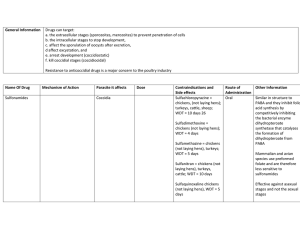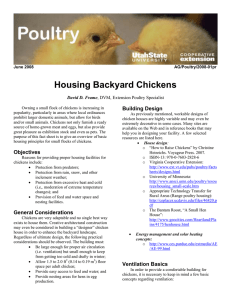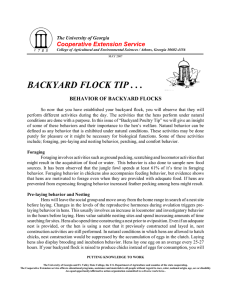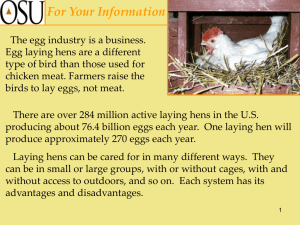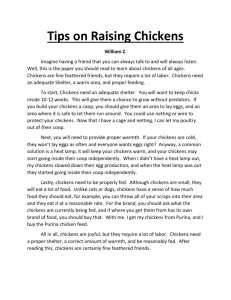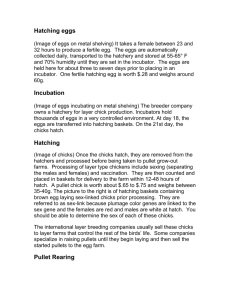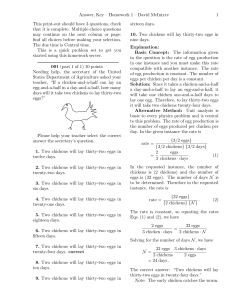BackyardPoultrymini
advertisement
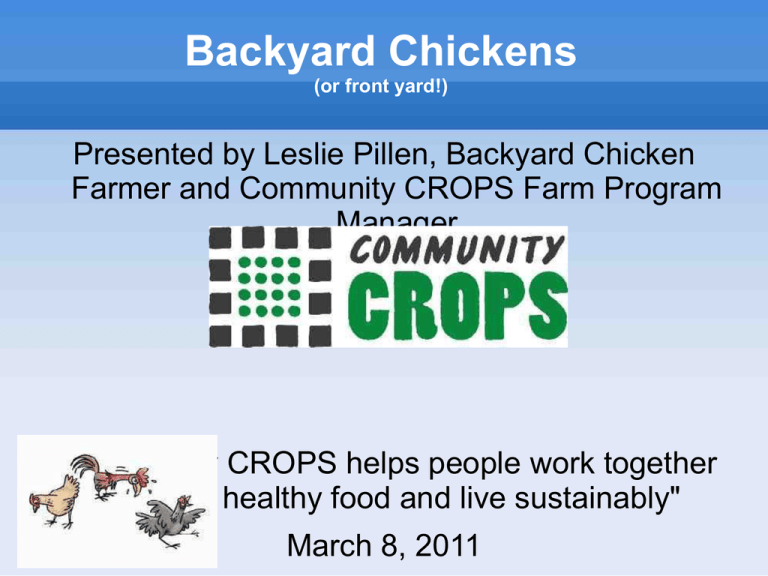
Backyard Chickens (or front yard!) Presented by Leslie Pillen, Backyard Chicken Farmer and Community CROPS Farm Program Manager "Community CROPS helps people work together to grow healthy food and live sustainably" March 8, 2011 Why keep chickens? • Fun pets for the whole family • Produce delicious eggs • Produce useful fertilizer • Help control insect pests • Relatively low-maintenance Why keep chickens? Because they're cool! Fun Facts About Chickens! 6.04.040 Pigeons, Small Animal, and Fowl Permit Requirements. (a) It shall be unlawful for any person to keep or harbor small animals or fowl, without a permit, in numbers equal to or greater than the minimum provided in Table 6.04.040. (b) It shall be unlawful for any person to keep or harbor small animals or fowl as follows: (1) In numbers greater than the maximum provided in Table 6.04.040; (2) Within pens, enclosures or shelters closer than fifty feet to a neighboring residence; or (3) Within pens, enclosures or shelters closer than five feet to a neighboring property line. Got That?? Basically... With 2 or less hens, you don't need a permit in Lincoln For 3-20 birds, you need a permit, which is $50/year No roosters allowed Birds must be 50ft. from neighbors' houses and 5ft. from property lines Make sure they don't smell bad Which came first? The chicken Chick Pullet Laying Hen The egg Laying Washing Eating! Parts of a Chicken Breeds Layers Broilers Dark Cornish Turken Chicks Selecting chicks Local options include Orscheln's, TSC Hatcheries include Central Hatchery Clean, Dry, Draft-Free Brooder Supplies • Orscheln's • Tractor Supply Company Pullets Chickens are called pullets when they're about to start laying eggs Most breeds start laying at 20 weeks Sometimes they need to be taught where to lay; you can teach them by placing a golf ball in the nest The nest box should be a fairly small, dark place with straw in it; they need to feel like it's a safe place to lay Laying Hens Full-grown hens will lay on average 300 eggs/year. They'll slow down some in winter when light levels drop. You can add supplemental light to maintain production. Chickens will molt every year or so. This is a process where they lose their feathers and grow new ones-sometimes slow and sometimes fast. Feeding hens Keep food available for laying hens always; broilers can over-eat Laying hens need 16% protein, plus calcium (sometimes the protein source is animal byproducts) Chickens will eat lots of things: kitchen scraps, bugs, grass, weed seeds, cheese Store feed in sealed containers Eggs • Brown, green, white or speckled • They'll lay between about 7am and 2pm • Keep fresh straw in the nest box to keep eggs clean; replace if it gets dirty • If dirty, clean with fine grit sand paper or water that is 10 degrees F warmer than the eggs • Chickens lay small eggs when young, and gradually larger eggs as they age • Keep them rotated in your fridge so you don't accidentally leave some for a long time Chickens in the winter Choose a hardy breed Keep chickens sheltered from moisture and drafts Consider a heated waterer and/or light The Henhouse • Mobile or stationary—benefits of each • Components include: – Coop: sheltered space for sleeping – Nest box: small, dark space for laying – Roost: 1-2 inch thick ledge; Upgrade from the doghouse Costs • Dumor 16% layer crumbles = $11.50 at TSC • One 50# bag lasts me about 2 1/2 months, without much grass and some kitchen scraps. • This means I spend $0.16 in feed/day for 2 birds. • Over-full feeders leads to extra cost. • Gallon drinker = $7.00 at TSC • The pen is the main cost. I spent about $70 just retrofitting a dog house with a run. Additional Resources wwww.urbanchickens.org www.thecitychicken.com www.backyardchickens.com
